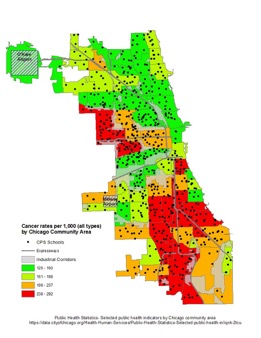Call It What It Is: Environmental Racism
By Kara Crutcher
Associate Editor, Vol. 24
 On March 15th, young people walked out of classrooms across the globe in the name of environmental justice. Following in the footsteps of 16-year-old Greta Thunberg – who’s been protesting Swedish lawmakers’ failure to implement the Paris Climate Agreement – young activists took to the streets to further emphasize that not only is climate change real, but that we need to take it more seriously as a global community.[2]
On March 15th, young people walked out of classrooms across the globe in the name of environmental justice. Following in the footsteps of 16-year-old Greta Thunberg – who’s been protesting Swedish lawmakers’ failure to implement the Paris Climate Agreement – young activists took to the streets to further emphasize that not only is climate change real, but that we need to take it more seriously as a global community.[2]
According to GreenAction, a grassroots organization based out of California dedicated to environmental justice work, environmental racism is defined as “the disproportionate impact of environmental hazards on people of color.”[3] This concept is exemplified by two major events within the past two decades – the effects of Hurricane Katrina in New Orleans and the Flint Water Crisis. In 2013 almost 80% of 9th Ward in New Orleans still had not returned to their homes because the city’s reconstruction efforts were lacking. Flint’s residents drank contaminated water for at least two years due to eroding pipes, highly contaminated water,[5] and a disregard for resident’s safety. Just like those affected in 9th Ward in New Orleans, Flint’s residents are overwhelmingly Black.
 The events related to Hurricane Katrina and the Flint Water Crisis are merely two grand-scale examples of environmental racism. However, it exists in the daily experiences of far too many Black and Brown people throughout the United States. For example, Black residents make up 14% of Michigan’s population, yet “the most polluted ZIP code in Michigan is in a southwest pocket of Detroit that is 84 percent black.” Similarly in Chicago, those most exposed to environmental pollutants are the city’s South Side residents who are overwhelmingly Black and Brown.[7] In fact, a Chicago steel mill was cited in 2018 for elevated levels of manganese dust on the city’s southwest side. There are currently thousands of Brown children that live in the area and that are at a much higher risk for learning disabilities and the numerous other damaging effects that manganese has on the body.[8] To be clear, this would never be allowed in Chicago’s wealthier neighborhoods.
The events related to Hurricane Katrina and the Flint Water Crisis are merely two grand-scale examples of environmental racism. However, it exists in the daily experiences of far too many Black and Brown people throughout the United States. For example, Black residents make up 14% of Michigan’s population, yet “the most polluted ZIP code in Michigan is in a southwest pocket of Detroit that is 84 percent black.” Similarly in Chicago, those most exposed to environmental pollutants are the city’s South Side residents who are overwhelmingly Black and Brown.[7] In fact, a Chicago steel mill was cited in 2018 for elevated levels of manganese dust on the city’s southwest side. There are currently thousands of Brown children that live in the area and that are at a much higher risk for learning disabilities and the numerous other damaging effects that manganese has on the body.[8] To be clear, this would never be allowed in Chicago’s wealthier neighborhoods.
The connection between environmental and racial justice seems quite clear, however, these instances are rarely framed as such in the media. Furthermore, the current president’s campaign promise to remove the United States from the Paris Climate Agreement means that our nation’s most vulnerable populations will be the most endangered. As we continue in the fight for environmental justice, it will be crucial that we strategize not only around lowering global greenhouse gas emissions, but that we recognize that society’s most vulnerable people are bearing the burden of our disregard for the health of the environment. As future lawyers, policy makers, and leaders of this nation, climate change needs to be discussed as inseparable from racial justice.
[1] Umair Irfan, Playing hooky to save the climate: why students are striking on March 15, Vox (Mar 14, 2019, 2:13pm), https://www.vox.com/2019/2/21/18233206/march-15-climate-strike.
[2] Id.
[3] GreenAction, Environmental Justice & Environmental Racism, http://greenaction.org/?page_id=420. (last visited Apr. 18, 2019).
[4] Jasmine Bell, 5 Things to Know About Communities of Color and Environmental Justice, American Progress (April 25, 2017, 9:04am), https://www.americanprogress.org/issues/race/news/2016/04/25/136361/5-things-to-know-about-communities-of-color-and-environmental-justice/
[5] CNN Library, Flint Water Crisis Fast Facts, https://www.cnn.com/2016/03/04/us/flint-water-crisis-fast-facts/ (last visited Apr. 22, 2019).
[6] John Eligon, A Question of Environmental Racism in Flint, New York Times (Jan. 21, 2016) https://www.nytimes.com/2016/01/22/us/a-question-of-environmental-racism-in-flint.html
[7] Brett Chase and Patrick Judge, Interactive Map: Pollution Hits Chicago’s West, South Sides Hardest, Better Government Association (Oct. 25, 2018) https://www.bettergov.org/news/interactive-map-pollution-hits-chicagos-west-south-sides-hardest
[8] Todd Williams, Toxicological Profile for Manganese, National Center for Biotechnology Information, (Sept. 2012) https://www.ncbi.nlm.nih.gov/books/NBK158868/
